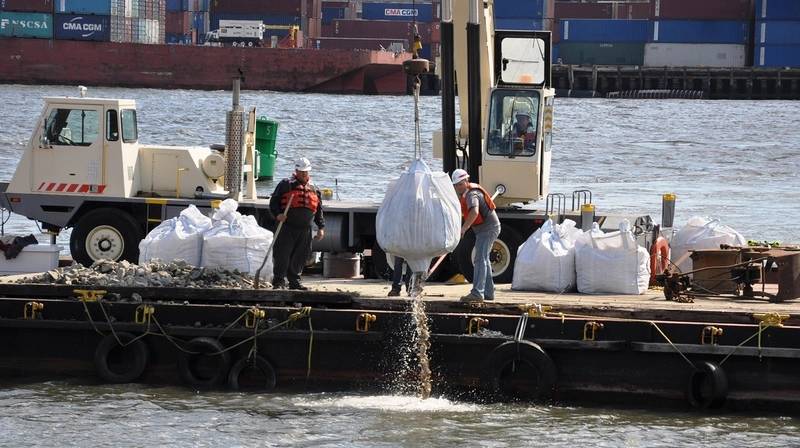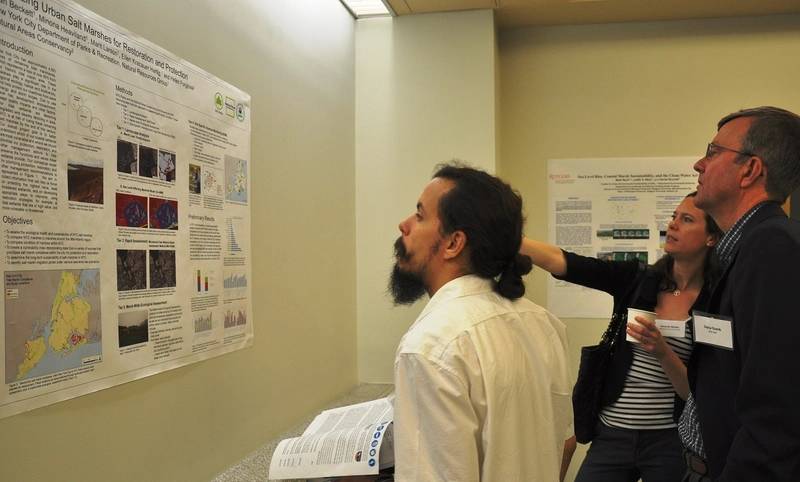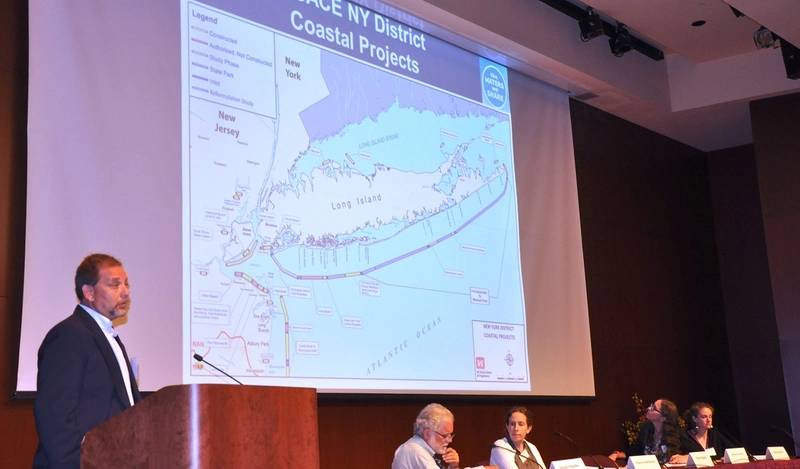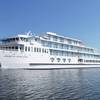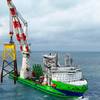Restoring the NY-NJ Harbor Estuary
Significant challenges often require a team effort. Restoring the New York-New Jersey Harbor Estuary is one of them.
A group of professionals from the Army Corps of Engineers, New York District, joined 200+ scientists, engineers, academics and restoration professionals on June 3, 2014 at a major symposium in Manhattan discussing progress restoring the NY-NJ Harbor Estuary and initiatives to continue improving the area’s ecological health, contributing to the region’s coastal resiliency. The conference, “Restoring the New York-New Jersey Harbor Estuary: Ensuring Ecosystem Resilience and Sustainability in a Changing Future,” was hosted by the NY-NJ Harbor Estuary Program’s Restoration Workgroup.
State of the Estuary: Past & Present
The Estuary, where fresh water from the Hudson, Hackensack, Passaic, Rahway and Raritan Rivers meets salt water from the Atlantic Ocean, provides a rich environment for plant and animal life. Spanning a 25-mile radius encircling the Statue of Liberty, the area includes 1,000 miles of coastline, 1,600 miles of open water and 500+ species of birds and fish.
Over the years, shoreline development and industrialization has destroyed nearly 85 percent of wetlands; oyster reefs (a bed of oysters filtering water and reducing wave action) and eelgrass beds (submerged aquatic plants) have completely disappeared. Most damage occurred prior to passage of the Clean Water Act in 1978, when wetlands were filled in with hard surfaces and storm-water runoff went unchecked. While the Estuary has improved since the 1980s, it’s still plagued by degraded habitat, poor water quality, contaminated sediments and impediments to fish swimming upstream. In addition, Hurricane Sandy battered shorelines and damaged wastewater treatment plants releasing over 10 billion gallons of untreated and partially-treated sewage, negatively impacting habitats.
Comprehensive Restoration Plan
But things are improving. The District, agency partners and regional stakeholders have been making progress for a number of years. In 1999, Congress authorized the Corps to conduct a feasibility study to develop a long-term restoration plan for the Estuary. In the following years, the draft Hudson-Raritan Estuary Comprehensive Restoration Plan (CRP) was released and ultimately adopted by NY-NJ Harbor Estuary Program (NY-NJ HEP) in 2009. As part of the CRP outreach efforts it’s been updated to include stakeholder input and lessons learned from Sandy. An executive summary of the 2014 plan was showcased at the symposium.
The CRP ─ a collaboration with the Port Authority of New York and New Jersey, the NY/NJ HEP and 100+ regional partners ─ is a master plan guiding conservation and restoration efforts in the region, serving as a shared vision of a vibrant Estuary. Lisa Baron, New York District Project Manager, and Peter Weppler, Chief, Environmental Analysis Branch, were major contributors. “A great deal of effort and input from nearly 130 organizations helped shape the 2014 Comprehensive Restoration Plan,” noted Baron. “The symposium was an excellent venue to highlight the revisions to the plan ─ targets and objectives, achievements, future opportunities, and meeting implementation challenges.”
Restoration Targets
The plan focuses on 12 Target Ecosystem Characteristics (measurable objectives related to ecosystem restoration), each representing an important feature needed for a healthy estuary. There are both short-term (2020) and long-term (2050) goals for each. Targets include:
- Wetlands: Create and restore coastal and fresh-water wetlands at a rate exceeding loss or degradation, resulting in a net gain in acreage.
- Habitat for water birds: Restore and protect roosting, nesting and foraging habitat (inland trees, wetlands and shallow shorelines) for long-legged wading birds.
- Coastal & maritime forests: Create a linkage of forests for migrant birds and plant communities.
- Oyster reefs: Establish sustainable oyster reefs at several locations.
- Eelgrass beds: Establish eelgrass beds at several locations.
- Shorelines & shallows: Restore shoreline vegetation, create sloped areas in tidal zones, and clear shallows (the bottom is visible).
- Habitat for fish, crab & lobsters: Create functionally-related habitats in each region of the Estuary.
- Tributary connections: Reconnect and restore fresh-water streams to the Estuary, promoting quality habitats for aquatic organisms.
- Enclosed & confined waters: Improve water quality in all enclosed waterways and tidal creeks, matching or exceeding receiving waters.
- Sediment contamination: Remove areas with contaminated sediment until all are free of pollution.
- Public access: Improve access to water and create linkages to recreational areas for swimming, boating and fishing.
- Acquisition: Protect environmentally-sensitive coastal areas from development through land acquisition.
Symposium Activities
Baron, Chair of the Harbor Estuary Program’s Restoration Work Group, opened the conference with a presentation, “The Waters We Share: A Shared Vision for Restoring the Estuary,” outlining revisions to the plan, updates, and restoration progress. She also moderated a panel, “Progress and Next Steps for Comprehensive Restoration Planning and Actions in the Estuary,” with participants sharing progress towards the goals.
Restoration Progress
Significant progress has been made since the 2009 draft Comprehensive Restoration Plan, including:
- Restoring 220+ acres of wetlands.
- Implementing 15 oyster pilot sites totaling 1.38 acres.
- Removing three dams on the Raritan River in New Jersey.
- Improving 18+ miles of fish habitat.
- Restoring 200+ acres of forest and 80 acres of dune and grassland habitat.
- Establishing seven eelgrass test beds.
- Acquiring 250+ acres for habitat preservation.
- Restoring habitat and foraging habitat (ability to seek or obtain food) of an island for water birds.
- Enhancing or acquiring 12 public access sites.
- Developing assessment tools and programs to improve the ecology of urban shorelines.
Historically, restoration activities centered on improving the Estuary’s health and providing ecosystem benefits. After Sandy’s severe impact, regional stakeholders are referring to the CRP to incorporate ‘green’ strategies to better manage flood risk, attenuate wave energy, and create more sustainable and resilient shorelines. This expanded focus was addressed by two panels. Weppler served on one discussing integrating nature-based features into coastal storm risk management with wetlands, oyster reefs, dunes and upland forests. He spoke about the District’s Sandy Coastal Restoration Program, ongoing studies and resiliency practices.
Exploring Partnerships
A third panel discussed the need for partnerships. A potential partnership could be the U.S. Department of Housing and Urban Development’s “Rebuild by Design” ─ a year-long competition where teams of architects, engineers and restoration professionals developed proposals promoting resilience in Sandy-impacted areas. One winner, “Living Breakwaters,” is a design that plans to manage flood risk to Staten Island’s south shore through a series of breakwaters reducing wave energy. A second, “The New Meadowlands,” is a system of berms and marshes designed to reduce ocean surges and collect rainfall reducing risk of sewer overflows in nearby communities.
Breakout groups focused on one central question: What ingredients are needed to meet the region’s challenging restoration agenda? Feedback included the need to: a) secure resources (capital, management, monitoring); b) improve community engagement; c) consolidate information into a single data center; d) overcome regulatory hurdles; and e) develop an evaluation tool balancing and integrating the benefits of nature-based (soft) and man-made (hard) coastal storm risk reduction measures.
Moving Forward
The next steps include finalizing the 2014 Comprehensive Restoration Plan that is expected to be available on the District’s Web site (www.nan.usace.army.mil) in fall 2014, and a feasibility study seeking new construction authority (funding) for restoration projects. Until then, work continues through existing programs.








